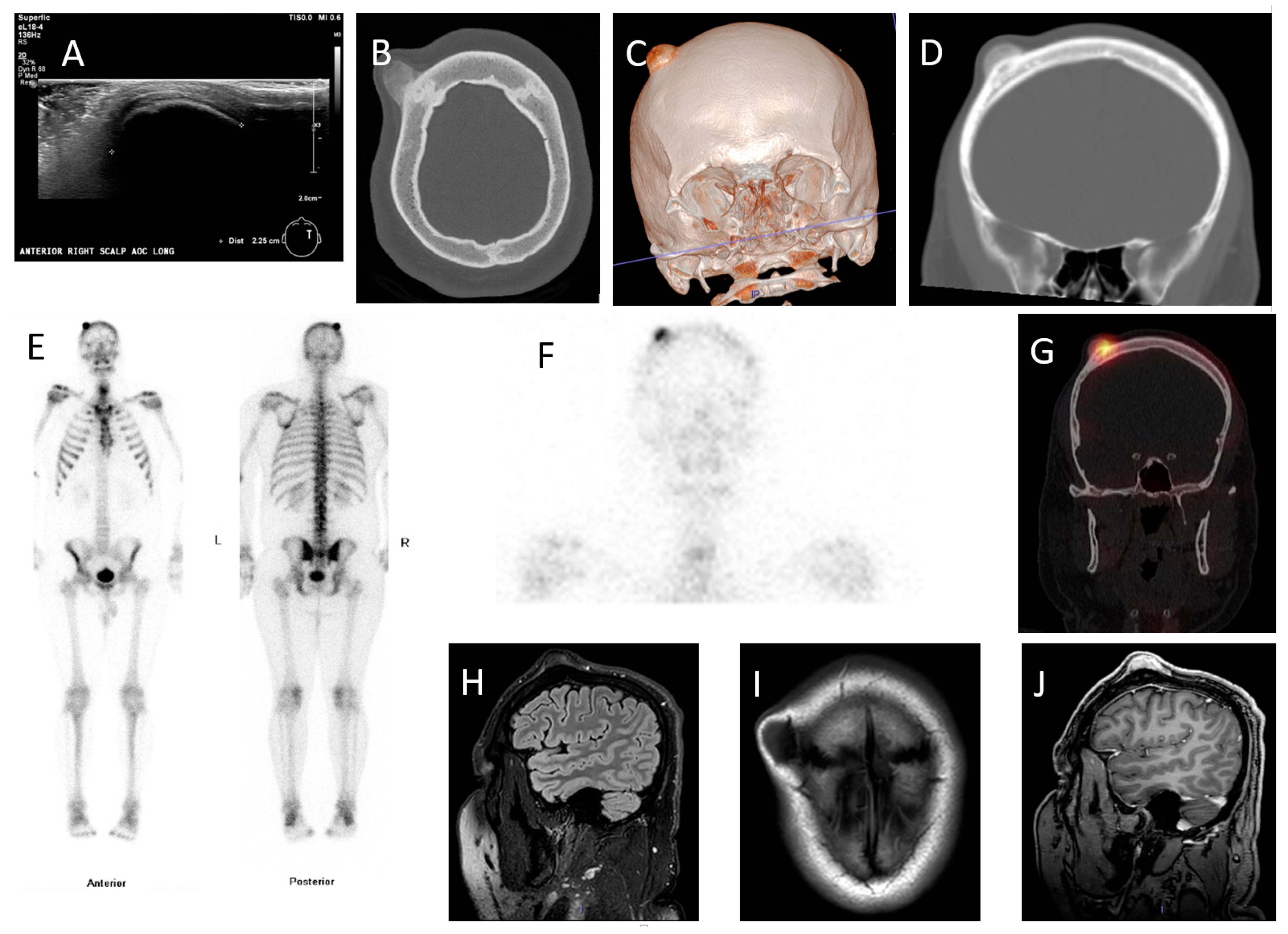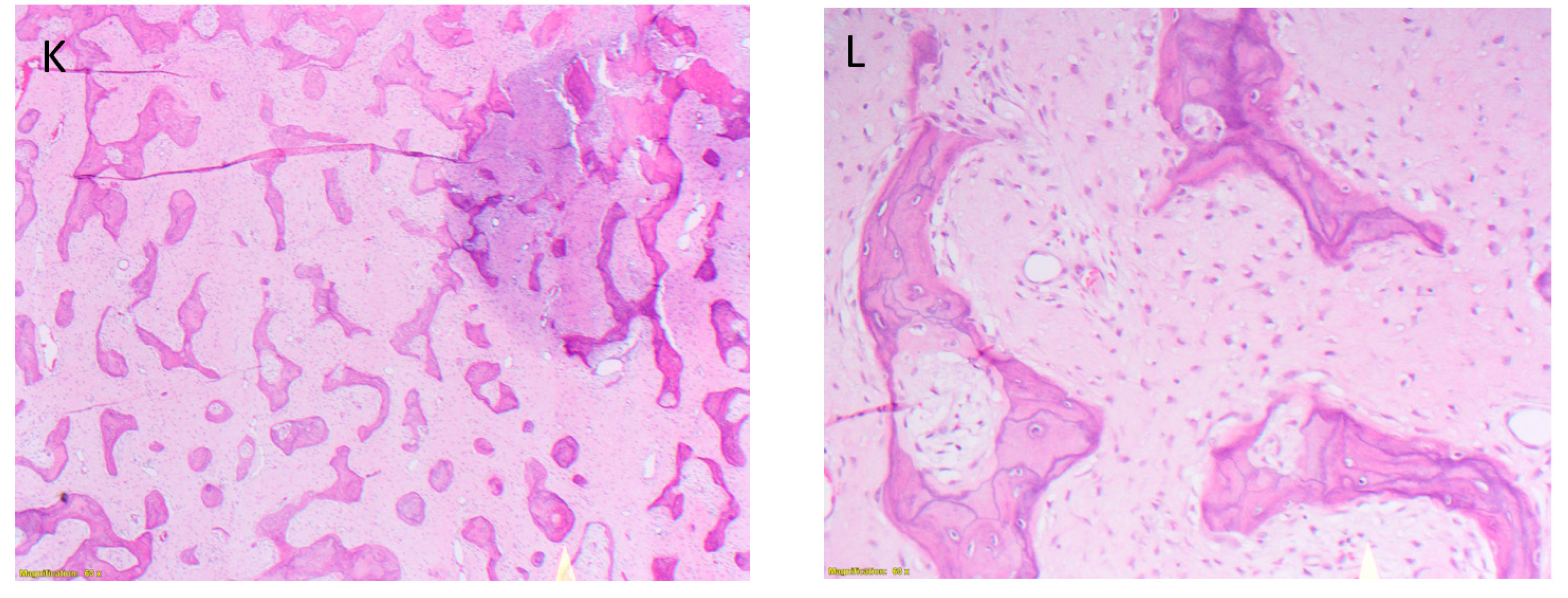Imaging of Fibrous Dysplasia Protuberans, an Extremely Rare Exophytic Variant of Fibrous Dysplasia
Abstract


Author Contributions
Funding
Institutional Review Board Statement
Informed Consent Statement
Data Availability Statement
Conflicts of Interest
Disclosures
References
- Kinnunen, A.R.; Sironen, R.; Sipola, P. Magnetic resonance imaging characteristics in patients with histopathologically proven fibrous dysplasia—A systematic review. Skelet. Radiol. 2020, 49, 837–845. [Google Scholar] [CrossRef] [PubMed]
- DiCaprio, M.R.; Enneking, W.F. Fibrous dysplasia. Pathophysiology, evaluation, and treatment. J. Bone Jt. Surg. Am. 2005, 87, 1848–1864. [Google Scholar] [CrossRef]
- Dorfman, H.D. New knowledge of fibro-osseous lesions of bone. Int. J. Surg. Pathol. 2010, 18, 62S–65S. [Google Scholar] [CrossRef] [PubMed]
- Dorfman, H.D.; Ishida, T.; Tsuneyoshi, M. Exophytic variant of fibrous dysplasia (fibrous dysplasia protuberans). Hum. Pathol. 1994, 25, 1234–1237. [Google Scholar] [CrossRef]
- Hamadani, M.; Awab, A.; Rashid, A.; Ali, T.; Brown, B. Fibrous dysplasia protuberans in a patient with McCune-Albright syndrome. J. Coll. Physicians Surg. Pak. 2006, 16, 376–377. [Google Scholar] [PubMed]
- Fitzpatrick, K.A.; Taljanovic, M.S.; Speer, D.P.; Graham, A.R.; Jacobson, J.A.; Barnes, G.R.; Hunter, T.B. Imaging findings of fibrous dysplasia with histopathologic and intraoperative correlation. AJR Am. J. Roentgenol. 2004, 182, 1389–1398. [Google Scholar] [CrossRef] [PubMed]
- Hwang, D.; Jeon, J.; Hong, S.H.; Yoo, H.J.; Choi, J.Y.; Chae, H.D. Radiographic Follow-Up of Fibrous Dysplasia in 138 Patients. AJR Am. J. Roentgenol. 2020, 215, 1430–1435. [Google Scholar] [CrossRef] [PubMed]
- Zhibin, Y.; Quanyong, L.; Libo, C.; Jun, Z.; Hankui, L.; Jifang, Z.; Ruisen, Z. The role of radionuclide bone scintigraphy in fibrous dysplasia of bone. Clin. Nucl. Med. 2004, 29, 177–180. [Google Scholar] [CrossRef] [PubMed]
Publisher’s Note: MDPI stays neutral with regard to jurisdictional claims in published maps and institutional affiliations. |
© 2021 by the authors. Licensee MDPI, Basel, Switzerland. This article is an open access article distributed under the terms and conditions of the Creative Commons Attribution (CC BY) license (https://creativecommons.org/licenses/by/4.0/).
Share and Cite
Haghighat Jahromi, A.; James, W.F.; Starsiak, M.D.; Silverman, E.D. Imaging of Fibrous Dysplasia Protuberans, an Extremely Rare Exophytic Variant of Fibrous Dysplasia. Diagnostics 2021, 11, 1006. https://doi.org/10.3390/diagnostics11061006
Haghighat Jahromi A, James WF, Starsiak MD, Silverman ED. Imaging of Fibrous Dysplasia Protuberans, an Extremely Rare Exophytic Variant of Fibrous Dysplasia. Diagnostics. 2021; 11(6):1006. https://doi.org/10.3390/diagnostics11061006
Chicago/Turabian StyleHaghighat Jahromi, Amin, William F. James, Michael D. Starsiak, and Eugene D. Silverman. 2021. "Imaging of Fibrous Dysplasia Protuberans, an Extremely Rare Exophytic Variant of Fibrous Dysplasia" Diagnostics 11, no. 6: 1006. https://doi.org/10.3390/diagnostics11061006
APA StyleHaghighat Jahromi, A., James, W. F., Starsiak, M. D., & Silverman, E. D. (2021). Imaging of Fibrous Dysplasia Protuberans, an Extremely Rare Exophytic Variant of Fibrous Dysplasia. Diagnostics, 11(6), 1006. https://doi.org/10.3390/diagnostics11061006





